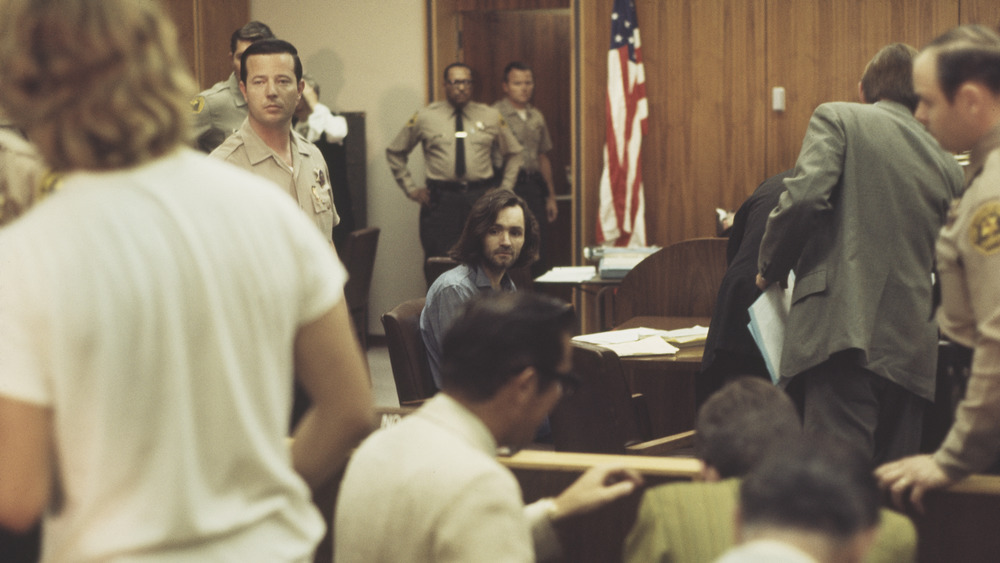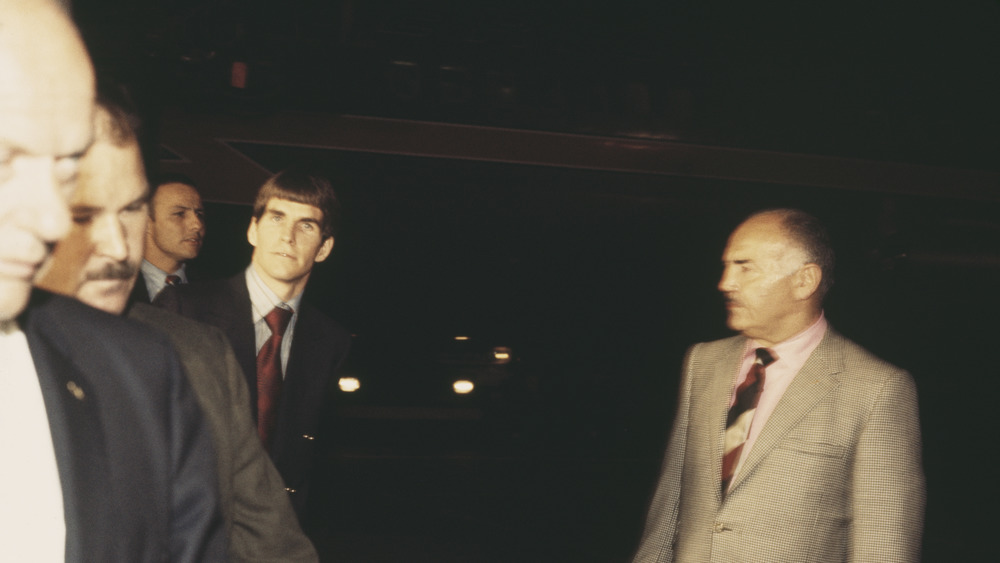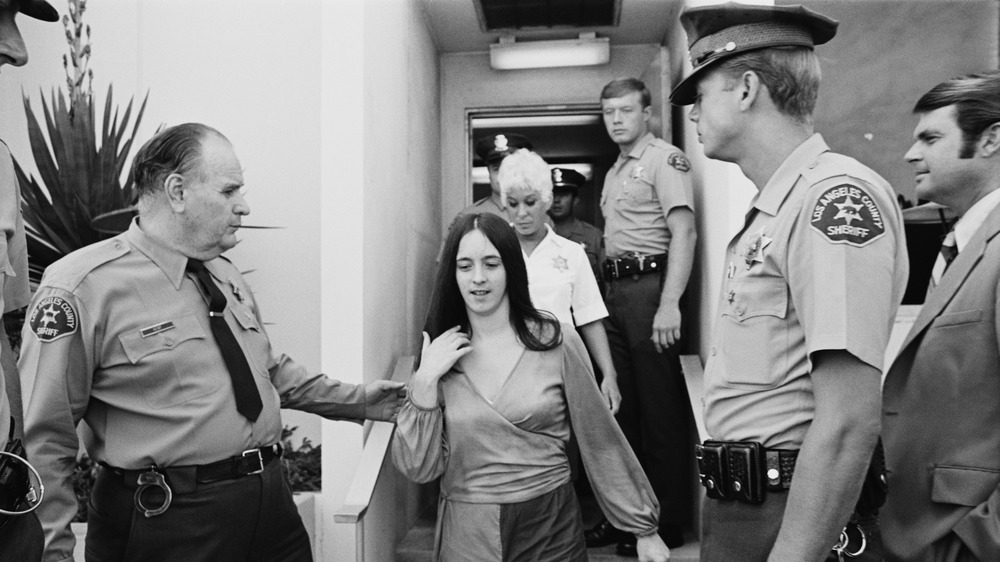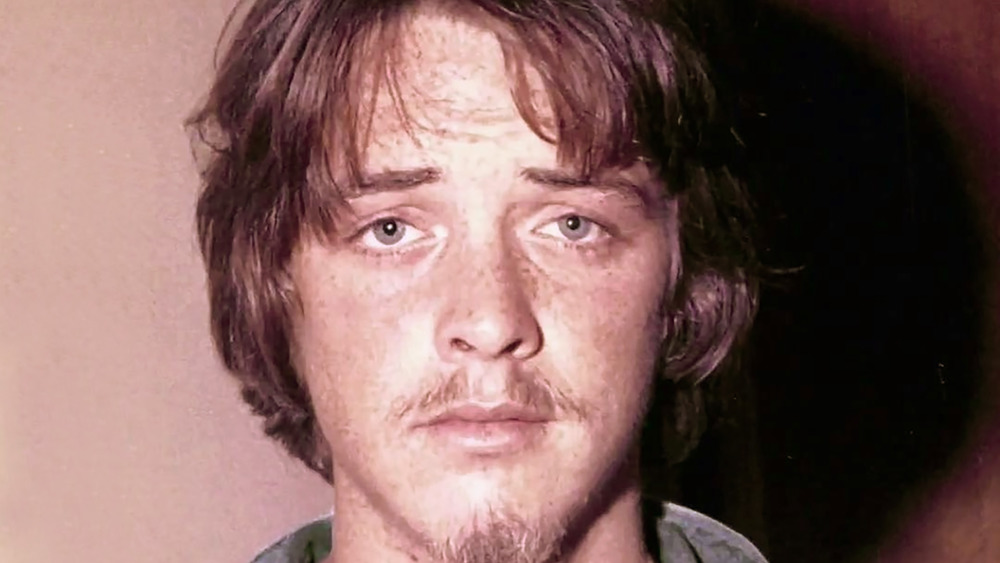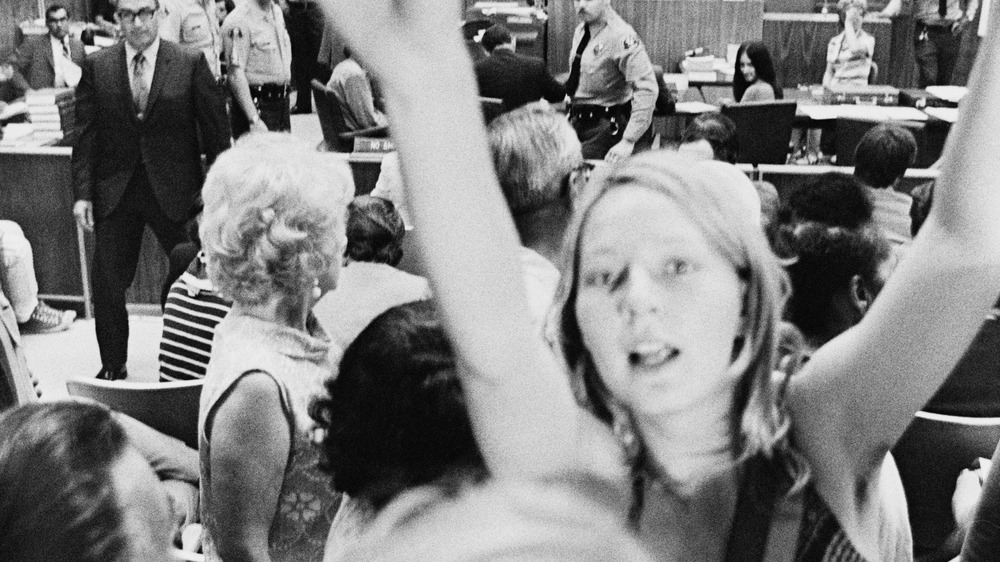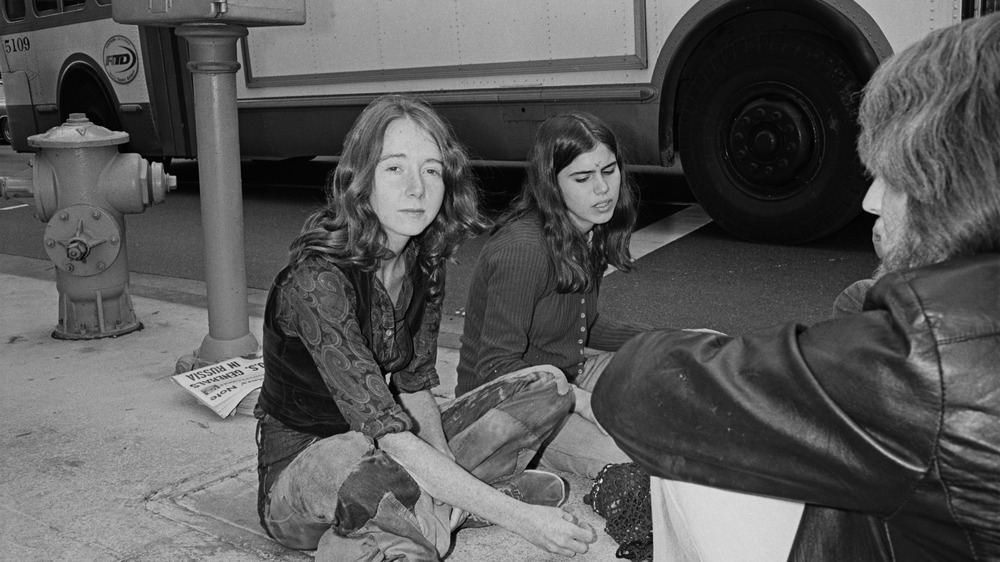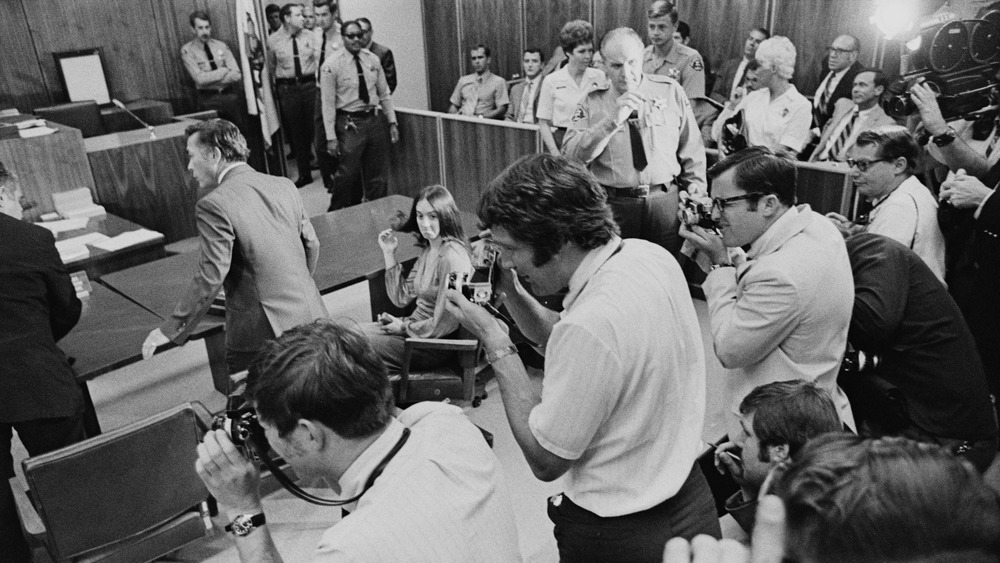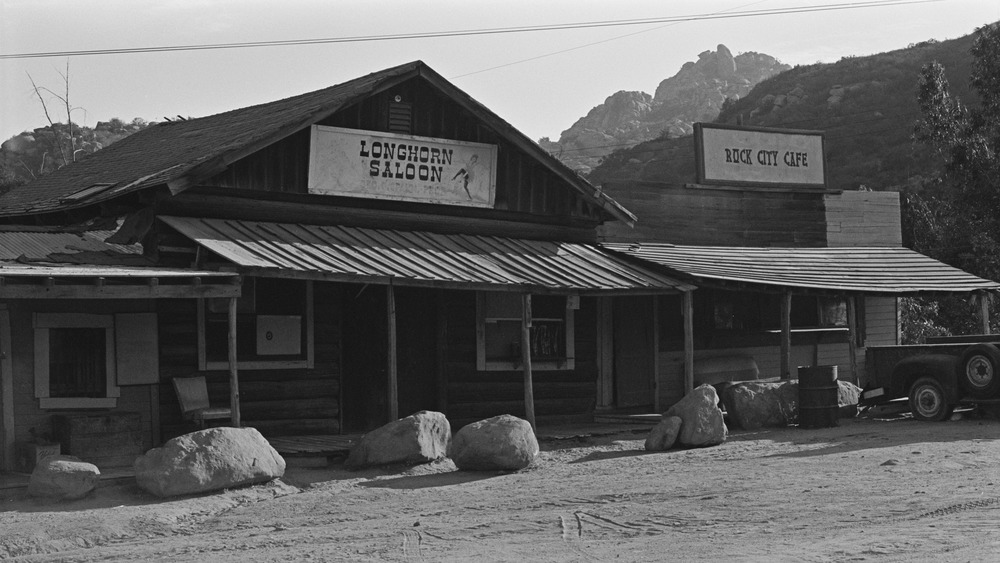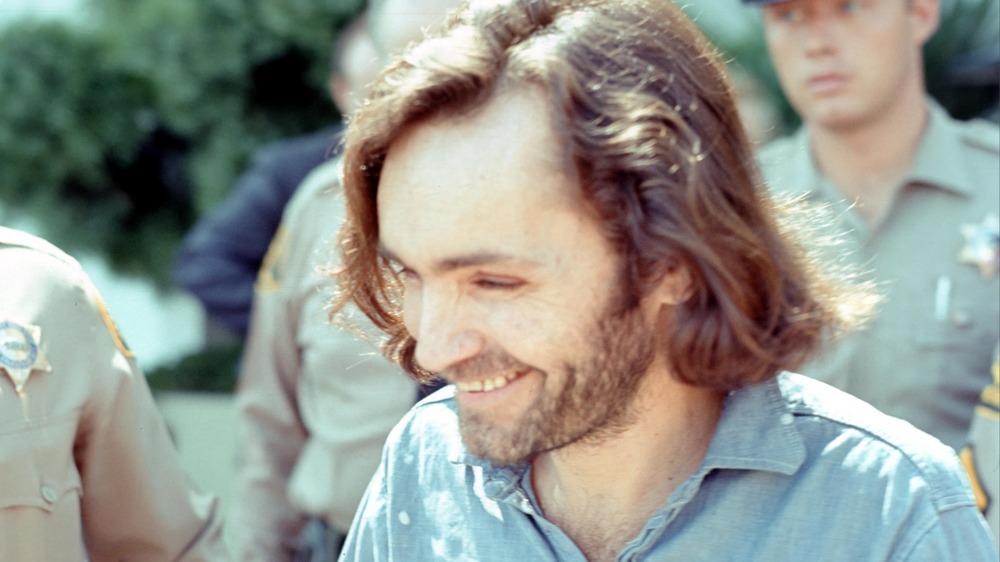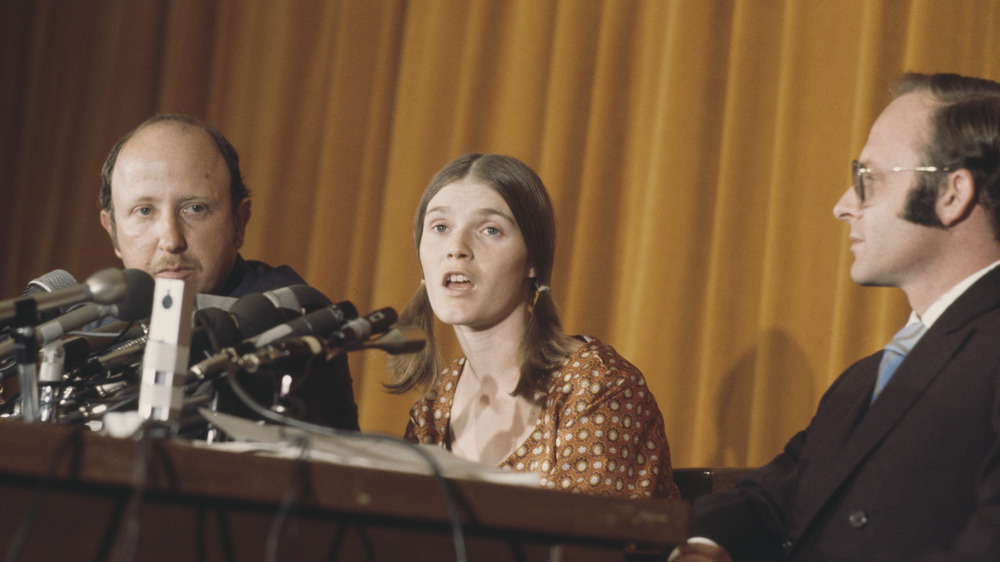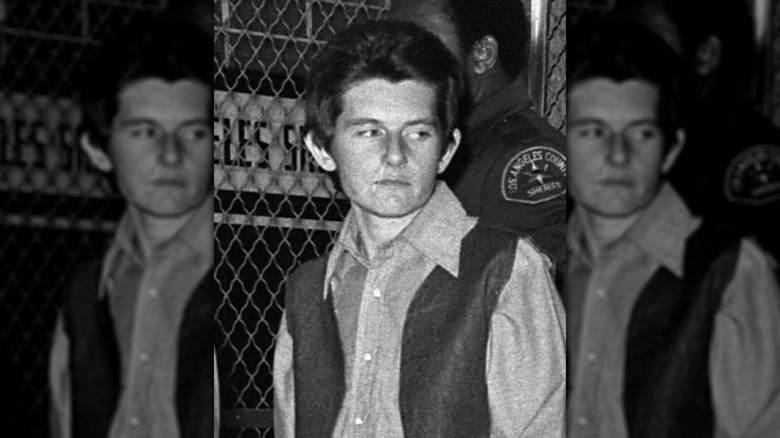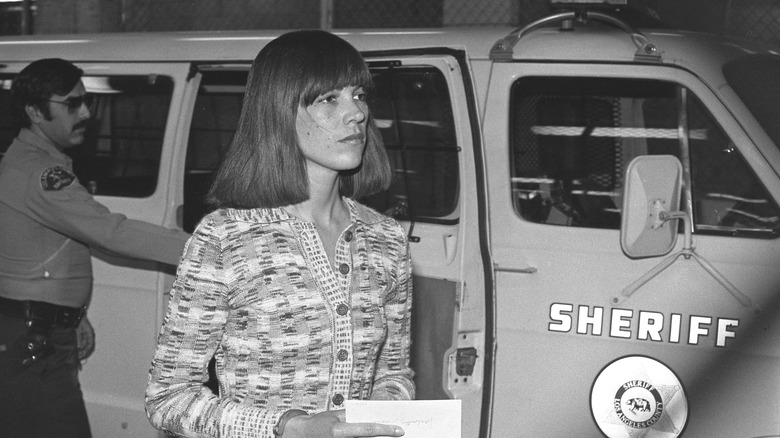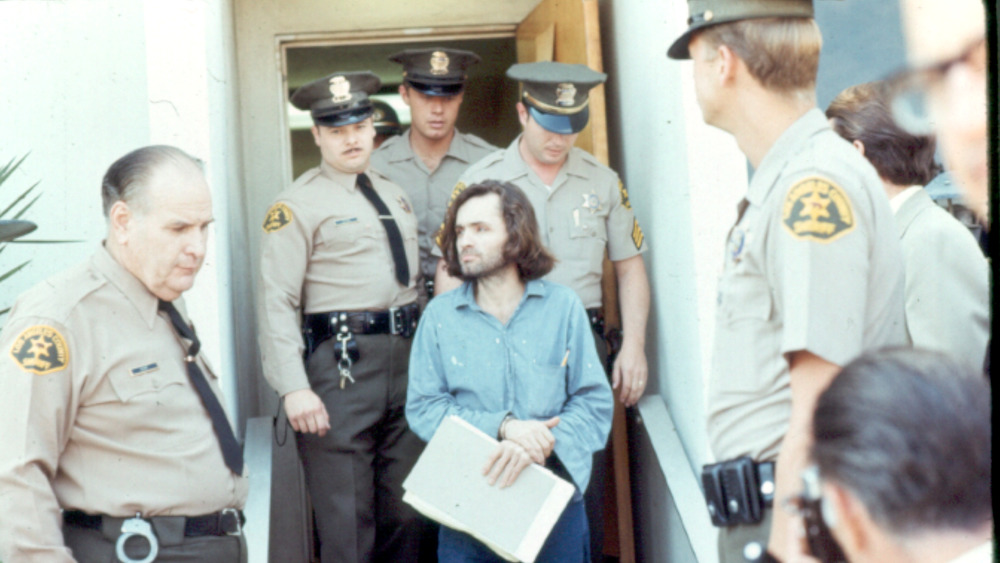What Happened To Every Charles Manson Follower?
Everyone knows the name of Charles Manson, one of America's most famous cult leaders. At the tail end of the 60s and its promises of peace and love, Manson's followers, called the Manson Family, committed a string of murders around Los Angeles that would become headline news.
On July 27, 1969, Gary Allen Hinman was murdered by the Manson Family. On August 10, Family members murdered actress Sharon Tate and several guests at her home, and the following night, performed a similar attack on the home of Leno and Rosemary LaBianca. On August 19, Manson's followers killed Donald "Shorty" Shea, just days after several Family members had been arrested.
Due to the expansive roster of the cult and the various interlocking crimes, it can be difficult to keep up with what happened to the Manson Family in the ensuing decades. Let's take a look at the aftermath of Manson's doings.
The following article includes descriptions of hate crimes, domestic abuse, and sexual assault.
Charles 'Tex' Watson
Charles Watson, called Tex by the Manson Family, was a driving force behind the Tate-LaBianca murders, and is sometimes referred to as Manson's right hand man. He directly participated in both murders and was seen as a sort of ringleader for the first, as Manson himself didn't attend the Tate murders. Watson is believed to have been the only one with a gun that night, thus making him the killer of at least two of the victims, according to All That's Interesting.
Watson continued living at the Family's primary headquarters, Spahn Ranch, for months after the murders. When he suspected police were closing in, he fled to his home state. There, he and his lawyers fought extradition to California, but eventually lost. Watson was sentenced to death, but in 1972, California temporarily outlawed the death penalty, commuting the sentences of all death row inmates to life in prison. This would be the case for most of the Manson followers who went to prison.
After his incarceration, Watson converted to Christianity and became a prison minister, according to Texas Monthly. He even got married. Watson and his wife had four children together thanks to California's conjugal visit policies, but these were banned in 1996. The couple divorced a few years later and he still remains in prison.
Susan Atkins
Susan Atkins was another major participant in the Manson cult murders, and the only member to participate in both the Hinman murder and Tate murders (although, according to the Los Angeles Times, she did not actively participate in the LaBianca murders). Atkins is believed to have been the Family member who wrote "PIG" in blood on the front door of the Tate residence. Amazingly, she's also the one who tipped the police off that Manson and his cult were behind the murders, albeit unintentionally, according to the Los Angeles Times. While serving time for auto theft, Atkins confessed to two fellow prisoners what she and the Family had done. The two passed word to the authorities who pieced this together with other evidence and began arresting Charles Manson's followers for the murders.
Later, Atkins testified against Manson and the others, even without a promise of immunity. Her own testimony helped put her away. She was warned of this beforehand but decided to testify anyway. It wasn't long after her death sentence (later commuted to life in prison, like Tex Watson) that Atkins began to turn against Manson and his followers. She became a born-again Christian and apologized for the crimes she had committed.
In the 2000s, Atkins was diagnosed with terminal brain cancer. She attempted to receive a compassionate release a few different times but was consistently denied. She died in prison in 2009 as a result of the cancer.
Bobby Beausoleil
Bobby Beausoleil was a musician before meeting Charles Manson and joining him, initially to make music together, but later as a member of Manson's Family. It was actually through Beausoleil that Manson became aware of Gary Hinman, another musician, drug dealer, and Beausoleil's friend that was rumored to be sitting on an inheritance worth a whole lot of money. Manson and his followers came to Hinman's house on July 25, 1969, where they kept him prisoner and tortured him for three days before Beausoleil killed his friend on July 27, according to Rolling Stone.
Beausoleil was caught just over a week later when Hinman's car, which Beausoleil had stolen, broke down on the side of the road and Beausoleil ended up falling asleep in it. He was convicted of murder and sentenced to death, while the other participants, Susan Atkins and Mary Brunner, weren't arrested until after the Tate-LaBianca murders. Beausoleil, too, had his conviction commuted to life — he is still incarcerated.
Beausoleil is the only Manson family member to have flourished in his career after being imprisoned. While Beausoleil made music prior to his conviction, he began recording albums in prison with the Freedom Orchestra, a collection of other musically inclined inmates. His works have gotten some attention on the outside, and he's also been known to produce various art pieces in prison as well.
Mary Brunner
While Mary Brunner was present at the murder of Gary Hinman, she didn't actively participate. This is, in fact, precisely why the authorities granted her immunity in the case to testify against Bobby Beausoleil. As the prosecution's star witness, Brunner gave precise details about the detainment, torture, and murder of Hinman, leading to the conviction of Beausoleil, according to All That's Interesting.
Then, something very odd happened. Despite rolling over on the Family, Brunner did not leave the cult. In fact, after she gave her testimony, she rejoined the still-free members of the cult and began calling for the release of the Family members convicted of the Tate-LaBianca murders. And her support didn't just end there.
In August of 1971, two years after the Tate-LaBianca murders, Brunner and other Family members held up a Western Surplus store, demanding all of the guns they had for sale. Before they could get away, police arrived and captured them. It turned out, the group's plan was to hijack a plane with the guns and threaten to shoot one passenger for every minute that Manson Family members weren't freed. Brunner was sentenced to 20 years for her role in the armed robbery, though she served far less. She was paroled in 1977 and subsequently retreated to a private life. She hasn't been heard from publicly since.
Bruce M. Davis
More than one Family member has been described as Manson's right-hand man. Bruce M. Davis was one who held this dubious title. While Manson initially sent Bobby Beausoleil, Susan Atkins, and Mary Brunner to confront and eventually murder Gary Hinman, Manson himself had Davis drive him out to Hinman's house. During their visit, Charles Manson is said to have used a sword to slash Hinman's face and ear, but he and Davis left before Hinman was actually murdered, according to Newsweek.
He was a participant in the murder of Donald "Shorty" Shea a few weeks later, however. The Family believed Shea, an employee of Spahn Ranch, may have turned them in to police over a string of auto thefts, so Manson ordered him killed. Davis was convicted for his role in the two killings. Unlike the others convicted of murder, though, Davis has actually almost gotten out several times, according to NBC Los Angeles.
Davis has become a preacher in prison and has had a clean disciplinary record for decades. His parole board has recommended him for release on multiple occasions, according to Rolling Stone. Each time, though, the recommendation has been overturned by three separate California governors — Arnold Schwarzenegger, Jerry Brown, and Gavin Newsom have all said no to Davis' release. His most recent parole hearing was in 2019, and he still remains in prison.
Lynette Squeaky Fromme
Contrary to popular belief, Lynette "Squeaky" Fromme was actually never convicted of any crimes related to the Manson family. While she was a big media presence throughout the Family's various trials and a die-hard supporter of the group, she never went to prison for them, according to All That's Interesting. She was jailed on a few occasions, but never charged with any of the Manson Family's various and assorted crimes, which she used to her advantage to spend a lot of time essentially acting as unofficial PR for the cult. Every chance at publicity Fromme could get, she took.
She didn't stay out of prison entirely, though. In 1975, Fromme confronted President Gerald Ford in a public park in Sacramento, where she pulled a gun on him and even pulled the trigger, but no round fired. Fromme was arrested and sentenced to life in prison. According to the courts, Fromme attacked Ford because of extremist environmental views she held. In 2009, despite escaping from prison briefly on one occasion and several instances of bad behavior, Fromme was paroled. She has not been in any legal trouble since.
Perhaps most disturbing of Fromme's story is that she is one of two Family members to never denounce Charles Manson. To this day, she still supports Manson's cause. As recently as 2019, in a TV interview, Fromme described herself as "still in love" with the now-deceased Manson, according to The New York Post.
Sandra 'Blue' Good
Sandra "Blue" Good is one of the Manson Family's high profile members who, like Lynette Fromme, managed to avoid going to jail for any of the cult's major crimes. She wasn't present for the Hinman murder and was in jail for credit card fraud during the Tate-LaBianca murders, according to The Hollywood Reporter. She openly supported the Family members who were jailed, alongside Fromme, and when Fromme was convicted of attempting to assassinate President Ford, Good stood up for her, too.
That's not to say she never went to jail. In 1975, Good and other Family members were convicted of sending death threats through the mail, a federal offense, to businesses she felt were harming the environment, according to The Evansville Courier & Press. She received a 15-year sentence, but only served a little less than 10. After her release, she could still be seen praising Manson and the Family in interviews, but otherwise kept her head down.
After Fromme's 2009 parole for her assassination attempt, she and Good ended up moving in together for a time and the two seem to still remain friends. She is the only other Family member, along with Fromme, to continue to support Manson to this day, never once turning her back on him. In a 2019 interview, (via Oxygen) she expressed thankfulness to the Family, saying they saved her life.
Clem Grogan
Steven "Clem" Grogan wasn't a lonely person, out looking for acceptance like most of the other members of the Manson Family. Instead, the Family found him. Grogan was a ranch hand working at Spahn Ranch, more or less Manson's headquarters. Once the cult moved in, he began seeing the group around more and more and talked to them a bit. That was all it took. Before long, Grogan was yet another member of Charlie's Family, according to crime writer H. Allegra Lansing.
While Grogan wasn't involved in the Hinman or Tate-LaBianca murders, he directly participated in the murder of Donald "Shorty" Shea, a fellow ranch hand that Manson suspected of bringing police attention to the Family. Later, Grogan cooperated with the authorities, even drawing a map to Shea's body, a piece of evidence that police were still missing.
Grogan has the unusual distinction of being the one and only Manson Family member to ever be released after being convicted for murder. Because he cooperated with police, was on copious amounts of drugs at the time of the murder, and a judge determined him to be below average intelligence, Grogan was decided to be fit for release in 1988 and has kept out of trouble ever since.
Barbara Hoyt
Through some combination of luck or wisdom, Barbara Hoyt managed to not be involved in any of the Manson Family's various crimes. In fact, she actually had the courage to testify against them, according to H. Allegra Lansing. Others who agreed to testify against Manson and his followers, like Susan Atkins, told a bunch of stories that don't necessarily align with the known facts. Barbara Hoyt, however, had information that was actually damaging to the cult. So much so that they tried to silence her by killing her.
As part of this plot, Hoyt was lured to Hawaii, where she was to be persuaded not to testify against the Family by Ruth Ann "Ouisch" Moorehouse. If that didn't go as planned, Moorehouse had one other directive: Kill her and stop her from testifying. Apparently, Moorehouse decided to take an unusual approach to this — she attempted to poison Hoyt by putting a large amount of LSD into a hamburger and got Hoyt to eat it.
Contrary to the Family's plans, though, this didn't kill Hoyt. She survived the attempt on her life, testified, and lived quietly as a nurse until she died in 2017. But there is one more twist to Hoyt's story. During the Manson Family trials, she met Debra Tate, Sharon Tate's sister, and amazingly the two became friends, even keeping in touch until Hoyt's death, according to Newsday.
Linda Kasabian
While there are plenty of Manson Family members who spent years pledging allegiance to the cult, Linda Kasabian was only part of the Family for about a month. Her experiences during that time would prove crucial to the cases against Manson and his Family, however, according to Vox.
Along with her one-year-old daughter, Kasabian left her husband and headed to California. She encountered the Family and decided to join. Soon, it turned out that Kasabian was the only member who still had a valid driver's license. It's for this reason that Kasabian was invited to join in on the Tate murders — she was the getaway driver and lookout. Kasabian had described the horrible things she experienced that night, but she was afraid to leave because of her daughter, who was still at Spahn Ranch.
The following night, she was asked to perform the same role for the LaBianca murders and she was too afraid to say no. Manson actually planned another murder that night, targeted at an actor acquaintance of Kasabian's. She drove to the actor's home, but intentionally knocked on the wrong door to stymie Manson's murder plans. After that, Kasabian fled from the Family with her daughter and reunited with her husband. She ended up becoming a star witness in the case against Manson himself, according to The Guardian. She then retreated from the public eye and led a quiet life, before dying in March 2023 at the age of 73.
Paul Watkins
Like Barbara Hoyt and Linda Kasabian, Paul Watkins managed to get away from the Manson Family without participating in any violence and testified against them too. It's actually through Watkins' statements that police first heard what "Helter Skelter," Manson's term for his imagined end-of-the-world scenario, would entail. According to Manson's prophecy, poor Black people would rise up against affluent whites, starting a race war. The Black people would win but (in a horribly racist twist) be unable to govern themselves, turning leadership of society over to the last white man, Manson, who had been hidden in the desert the whole time.
When Watkins heard Manson describe his vision, it scared the crap out of him, because he knew exactly where Manson's words would lead — to violence, according to All That's Interesting. In fact, shortly after hearing Manson say that Helter Skelter was taking too long to get started, Watkins decided to get out, and after he found out about the Tate-LaBianca murders, he went to the police.
Paul Watkins began sleeping in his van after leaving the Family, according to The Guardian. One night, he awoke to his vehicle in flames, however, and Watkins suffered burns, including to his vocal cords. This led to Watkins deciding to testify in court. He served no jail time, and later in life, became a lecturer on cult psychology and substance abuse. He died in 1990 of leukemia.
Patricia Krenwinkel
As of 2023, a member of the Manson Family has been the longest-serving female inmate of the Californian justice system. For a time, it was Susan Atkins, but after her death in 2009, Patricia Krenwinkel became the record holder. Aged 74 when last recommended for parole in 2022, Krenwinkel has been incarcerated since 1971, when she was sentenced in connection with the murder of Sharon Tate and her houseguests: Krenwinkel specifically confessed to stabbing Abigail Folger. She was also party to the killing of the LaBiancas, and was the one who wrote out sayings with their blood, as reported by The Guardian.
She joined up with Manson when she was 19. In testimony from 2016, she said that she was lured away from her job and the home she shared with her sister by the promise of romance. But Manson, Krenwinkel claimed, beat her, kept her plied with drugs, regularly sold her for sex, and almost never left her alone.
Changes to California law in 2017 required that a parole board consider Krenwinkle's age, both when the murders were committed and at the time of a parole hearing, when making decisions. She was recommended for parole in 2022 after being denied 14 times, but Tate's sister Debra was outspoken in doubting the review process and Krenwinkle's rehabilitation (per the Los Angeles Times). Governor Gavin Newsom, citing similar concerns, denied the parole that same year.
Leslie Van Houten
The youngest member of the Manson Family was Leslie Van Houten. She was a teenage runaway when she first encountered Charles Manson at 19, having fled a broken home two years prior. After her arrest, Van Houten told authorities that she was brainwashed and controlled by Manson through a combination of drugs, sex, Beatles songs, and Bible verses incorporated into Manson's lectures. She was not party to the murder of Sharon Tate, but she did confess to smothering Rosemary LaBianca while other members of the family stabbed her, then took up the knife herself under orders from Charles Watson.
In prison, Van Houten was always on her best behavior and repeatedly expressed remorse for her crimes. Her contrition, and her age at the time of the killings, have been a regular argument made by her attorneys to parole boards since 1979, according to the Los Angeles Times. She was recommended for parole in 2016, 2017, and 2020. But Van Houten's release was always opposed by relatives of the LaBiancas. And governors Jerry Brown and Gavin Newsom previously denied her release. A bid to overturn Newsom's decision failed with the California supreme court in 2022. However, in July 2023, Van Houten was released on parole, albeit with reservations by Newsom who disagreed with the decision but also decided not to appeal.
Charles Manson
Charles Manson's followers either went to prison for him or turned on him, leading to his own imprisonment for murder. He stayed there for the rest of his life, never coming close to being paroled, until he died in 2017, according to Newsweek. While there's some question over whether Manson directly participated in any of the murders (he did shoot a drug dealer named Bernard Crowe shortly before the Tate-LaBianca murders, but Crowe lived), his influence over the Family members who did commit murder was enough to get him locked up.
While imprisoned, Manson was notorious for his publicity stunts, like carving an X into his forehead which he later turned into a swastika, and giving rambling, incoherent interviews to the press. Was he truly unhinged, under or over-medicated for his diagnosed schizophrenia, or just playing it up as an act? We may never know for certain, but each scenario is fairly plausible.
It is notable that Manson never received parole not just because of the seriousness of his crimes, but also because he couldn't stay out of trouble, according to The Los Angeles Times. He was accused of breaking hundreds of prison rules during his incarceration, including assault, possessing weapons and drugs, and even smuggling in cell phones. Much like his time spent as a cult leader in California, Charles Manson seemed to always have trouble believing that the rules applied to him, too.
